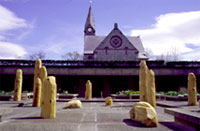Permanent Sculpture Installation purchased by the University of Massachusetts. Hand chiseled surface. A traditional Japanese technique of hallowing, pinning, and joining is used for the larger pieces. Joined with epoxy and preserved with Tung Oil, Bolted to concrete, Du Bois Library Sculpture Courtyard, University of Massachusetts, Amherst, MA.
Wood: Pine. Varying heights: 8′ to 2′. 1999.
How and when it happened I do not know, But my Ox is gone!
Searching for the stray Ox,
I am now entering into the remote mountains of meditation.
~Zen Poem
This is the first in a series of ten paintings called the Ox herding pictures. In my sculptures of mountains, I see people, buddhas, spirits, nature, and rocks. I am searching within myself, within the forms that I carve, in people, in nature, and in the world around me. The Buddha teaches us that there is Buddha-nature in all of us, and in everything.
This installation consists of a series of sculpted wooden forms that resemble mountains. Their arrangement is inspired by the rocks in Japanese dry gardens. I am creating with nature, but instead of using natural rocks, I carve wood. I call them Searching for the Buddha in the Mountains, because they remind me of the first of the ten Zen Oxherding Pictures. The sculptures range in height from one foot to eight feet. There are nine carved wooden abstract forms alluding to mountains/ rocks/ people/ spirits/ Buddhas.
The wood was picked and transported to UMASS on a lumber truck. It was roughed out with a chainsaw, then hollowed out with a chainsaw, drill, and adze. The final surface was carved with chisels. The inside surface was coated with one coat of outdoor oil preservative. To laminate the larger pieces, they were hand planed, drilled, dowel pinned, and joined with epoxy. The outside surface was coated with four coats of outdoor oil preservative. The bottoms of the sculptures were coated once more with epoxy. Two final coats of Tung oil were applied to the outer surface.
These sculptures are made of wood, hollowed and joined. This traditional Japanese technique,yosegi tsukuri, has been used in the creation of Buddhist statues for centuries. Yosegi tsukuri is unique to Japan. It enables the making of large-scale sculptures from smaller pieces of wood and prevents checking (cracks).
The surfaces have been preserved with Tung oil that has been used on Chinese boats for centuries. The West System Epoxy is a marine epoxy. The sculptures are carved from pine wood, which is rot resistant. Tung oil should be re-applied every three years. With the proper care, the sculptures will last indefinitely.
I am trying to synthesize Eastern and Western cultures, bringing together aspects of both— freedom and discipline, tradition and change, ritual and openness, spirituality and materialism. Drawing from both traditions, I strive to create something new that goes beyond either.

